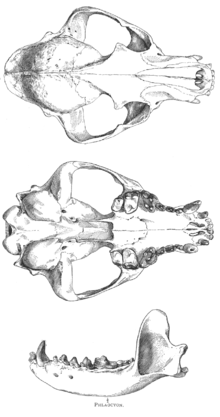Phlaocyon
| Phlaocyon | |
|---|---|
 | |
| Type specimen of Phlaocyon leucosteus | |
| Scientific classification | |
| Kingdom: | Animalia |
| Phylum: | Chordata |
| Class: | Mammalia |
| Order: | Carnivora |
| Family: | Canidae |
| Subfamily: | †Borophaginae |
| Tribe: | †Phlaocyonini |
| Genus: | †Phlaocyon Matthew 1899, p. 54 |
| Type species | |
| †P. leucosteus | |
| Species | |
| |
| Synonyms | |
| |
Phlaocyon (from Greek phlao, "eat greedily" and cyon, "dog")[1] is an extinct genus of the Borophaginae and a terrestrial canid which inhabited most of North America during the Whitneyan stage of the Early Oligocene through Late Hemingfordian stage of the Early Miocene epoch 33.3–16.3 Mya existing for approximately 17.3 million years.[2] It is closely related to Cynarctoides.
Phylogeny
When discovered in the 19th century and during the following decades, Phlaocyon was thought to be ancestral to raccoons because of shared convergent adaptations toward hypocarnivorous dentitions, but Hough 1948 was the first to discover the canid nature of the middle ear region in P. leucosteus and Phlaocyon in now believed to be part of very diverse clade of hypocarnivorous canids, the Phlaocyonini, and only distantly related to raccoons.[3]
P. mariae and P. yatkolai, both known from isolated teeth and fragmentary material, are the largest and most derived species, and both display a tendency away from the hypocarnivorous dentition of the genus and towards a more hypercarnivorous dentition.[4]
Anatomy
Phlaocyon was about 80 centimetres (31 in) in body length, and looked more like a cat or raccoon than a dog, but its skull anatomy shows it to be a primitive canid. Phlaocyon probably lived like a raccoon, often climbing trees. Its head was short, wide, and had forward-facing eyes. Unlike modern canides, Phlaocyon had no specialised teeth for slicing flesh. It is thought to have been an omnivore.[5]
Legendre & Roth 1988 estimated the body mass of two specimens to be 1.81–1.87 kilograms (4.0–4.1 lb).[6]
Fossil distribution
- Foree Site, John Day Formation, Wheeler County, Oregon (P. latidens) ~30.8–20.6 Ma.
- Brooksville 2 Site, Hernando County, Florida (P. taylori) ~30.8–20.6 Ma.
- SB-1A Live Oak Site, Suwannee County, Florida (P. leucosteus) ~24.8–20.6 Ma.[7]
- Buda Mine, Alachua County, Florida (P. indent) ~24.8–20.6 Ma.[8]
- Wewela Site, Tripp County, South Dakota (P. minor) ~26.3–24.8 Ma.
References
Notes
- ↑ Wang & Tedford 2008
- ↑ "Phlaocyon". Fossilworks. Retrieved September 2014. Check date values in:
|accessdate=(help) - ↑ Wang, Tedford & Taylor 1999, p. 66
- ↑ Wang, Tedford & Taylor 1999, pp. 83–85
- ↑ Palmer 1999, p. 312
- ↑ Legendre & Roth 1988
- ↑ "SB-1A ( of the United States)". Fossilworks. Retrieved September 2014. Check date values in:
|accessdate=(help) - ↑ "Buda Mine Site". Fossilworks. Retrieved September 2014. Check date values in:
|accessdate=(help)
Sources
- Cope, E. D. (1881). "On the Nimravidae and Canidae of the Miocene period". Bull. U.S. Geol. Geogr. Surv. Territories. 6: 165–181. Retrieved September 2014. Check date values in:
|accessdate=(help) - Frailey, D. (1979). "The large mammals of the Buda Local Fauna (Arikareean: Alachua County, Florida)". Bull. Florida State Mus. Biol. Sci. 2 (2): 123–173. Retrieved September 2014. Check date values in:
|accessdate=(help) - Hayes, F. G. (2000). "The Brooksville 2 local fauna (Arikareean, latest Oligocene) Hernando County, Florida". Bulletin of the Florida Museum of Natural History. 43 (1): 1–47. Retrieved September 2014. Check date values in:
|accessdate=(help) - Hough, J. R. (1948). "The auditory region in some members of the Procyonidae, Canidae and Ursidae: its significance in the phylogeny of the Carnivora". Bulletin of the AMNH. 92. Retrieved September 2014. Check date values in:
|accessdate=(help) - Legendre, S.; Roth, C. (1988). "Correlation of carnassial tooth size and body weight in recent carnivores (Mammalia)". Historical Biology. 1 (1): 85–98. doi:10.1080/08912968809386468.
- Matthew, W. D. (1899). "A provisional classification of the fresh-water Tertiary of the West". Bulletin of the AMNH. 12. Retrieved September 2014. Check date values in:
|accessdate=(help) - Matthew, W. D. (1907). "A lower Miocene fauna from South Dakota". Bulletin of the AMNH. 23: 169–219. Retrieved September 2014. Check date values in:
|accessdate=(help) - McGrew, P. O. (1941). "A new procyonid from the Miocene of Nebraska". Field Museum of Natural History. 8 (5): 33–36. Retrieved September 2014. Check date values in:
|accessdate=(help) - Palmer, D., ed. (1999). The Marshall Illustrated Encyclopedia of Dinosaurs and Prehistoric Animals. London: Marshall Editions. ISBN 1-84028-152-9.
- Peterson, O. A. (1907). "The Miocene beds of western Nebraska and eastern Wyoming and their vertebrate faunae". Annals of the Carnegie Museum. 4: 21–72. Retrieved September 2013. Check date values in:
|accessdate=(help) - Romer, A. S.; Sutton, A. H. (1927). "A new arctoid carnivore from the lower Miocene". American Journal of Science. 5. 14 (84): 459–464. doi:10.2475/ajs.s5-14.84.459.
- Wang, X.; Tedford, R. H. (2008). Dogs: Their Fossil Relatives and Evolutionary History. New York: Columbia University Press. ISBN 978-0-231-13528-3. (with illustrations by Mauricio Antón)
- Wang, X.; Tedford, R. H.; Taylor, B. E. (1999). "Phylogenetic systematics of the Borophaginae (Carnivora, Canidae)". Bulletin of the AMNH. 243. Retrieved September 2014. Check date values in:
|accessdate=(help)